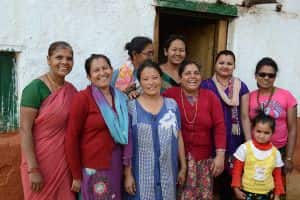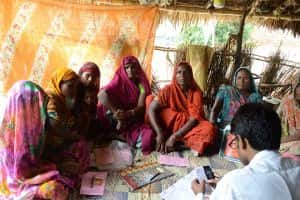Now that you have completed the Courage of One Challenge with The Hunger Games: Mockingjay – Part I South Asia Quiz you want to know more? Here are some more details about the the poverty challenges in the region.
Financial Inclusion: Asia/Pacific
Despite on-going economic growth across the region, there remain some of the least developed countries in the world in Asia such as Cambodia, Nepal, East Timor, and Lao PDR for example. Poverty remains prevalent in Asia/Pacific.
With that said, after a period of rapid growth until around 2010, outreach of microfinance globally now seems to be leveling off. The study conducted by the Microcredit Summit Campaign reveals that the number of people receiving microloans in the world fell for the first time from 205 million in 2010 to 195 million in 2011.
The Microcredit Summit Campaign has tracked the total number of clients served by microcredit and the number of those who were among the world’s poorest every year since 1998. And every year those numbers have increased, often by 20% to 40%—until last year. When we collected the numbers last year, we found that 13 million fewer of the world’s poorest families had received loans in 2011 than the previous year.”
There are a number of crucial reasons behind the decrease, but none as significant as India, where a reduction of an estimated 14.2 million in the number of microcredit beneficiaries was observed, due to the crisis of confidence in Indian MFIs, following the 2010 Andhra Pradesh crisis.
Outreach:
Yet this episode should not hide the fact that 2.5 billion people worldwide have no access to formal financial services. East Asia and Pacific (EAP) contains a significant share of the world’s population (27%) and the world’s poor (24%) where ample room for continued growth will continue to exist.
Data from the World Bank Global Findex database (Demirguc-Kunt and Klapper 2012) shows that low usage does not, however, indicate weak demand. In South Asia for example, only 11 percent of individuals aged 15 years and older saved at a financial institution in the last 12 months, and only 9 percent received a loan from a financial institution. When compared to the potential market of the 900 million households in India alone that live on less than US$2 a day (Chen et al. 2010) substantial underserved or un-served communities lack opportunities that access to basic financial services provides.
Efficiency and Profitability:
In general, the microfinance sector in Asia is one of the most developed and continues to evolve particularly with consistent emphasis on efficiency achieved by growth and scale. Even as efficiency improvements have slowed, MFIs in Asia continue to serve borrowers at the lowest cost level of any region globally. Amongst WPFs partners, Cost/borrower is lowest in the Asia/Pacific portfolio averaging $72.18 while the Operating expense ratio averages 25.47% in 2013.
Even with average loans being as small as they are, the delivery efficiency has ensured that MFIs remain profitable in the region. The South Asian countries, Nepal being one clear exception, are helped by the high density of population which enables field officers to serve a larger number of customers. Amongst the WPF Asia/Pacific portfolio all partners but one have reached “break-even” and are now operating profitably.
Asia Microfinance Networks:
There are a number of sub-regional yet mostly national microfinance networks and/or associations that enjoy considerable involvement from the local microfinance sector. In regards to a regional microfinance network, The Banking with the Poor Network (BWTP) is an Asian association of a diverse range of microfinance stakeholders committed to improving the quality of life of the poor through promoting and facilitating their access to sustainable financial services. The BWTP Network has emerged to become the largest regional microfinance network in Asia, with a total current membership of 61 institutions – from 14 countries in the region with 42 MFIs, 10 Microfinance Networks, 8 Non-MFIs and 1 central bank.
Risks and Challenges:
In general, the greatest risk facing the microfinance sector remains over-indebtedness, and multiple borrowing. According to the Mix Market, credit-only MFIs in Asia are citing client-indebtedness as the leading factors for both outreach and risk, while deposit-taking MFIs are citing competition for outreach. Excessive lending into local saturated markets raises the sector-wide risk and potentially burdens borrowers with debts they did not need.
Along these lines, The Microcredit Summit Campaign outlines the following “lessons learned” on the blog post, “A Time of Reckoning” concerning the microfinance sector as a “social business” and what it entails when working with the bottom of the pyramid concerning financial inclusion:
- Focusing solely on growth can lead to a breakdown of discipline and economic bubbles that can destroy lives and markets when they burst. Thus, responsible finance with a defined and tracked pro-poor methodology is crucial.
- Social enterprise frequently involves serving marginalized people, which often means that there will be a large power imbalance between the provider of the products and services and those that use them. Thus, these businesses need to set for themselves performance standards and feedback mechanisms to make sure that they are not abusing the power that they have over their clients.
In a sense, these points now cautioning against rapid expansion are ever more valuable coming from the organization that launched the “microfinance campaign” back in 1997 to reach 100 million of the world’s poorest families, with credit by the year 2005; a goal that has since been far surpassed.
In summary:
The Asian microfinance sector has demonstrated leadership in the global arena through its impressive scale of outreach and tight operating cost. With large underserved markets, Asia still offers tremendous opportunities for the expansion of existing and greenfield institutions within the region. Asian MFIs will face the dual challenge of continuing to promote strong growth in under or un-served areas while working to avoid client over indebtedness in already saturated markets or operating environments.
Microcredit is only one component of microfinance, which is also intended to provide suitable savings, insurance, payment and money transfer services, to people excluded from the financial system. Also, microfinance has proven to be an excellent platform to launch into non-financial or credit plus services including health, water and sanitation, education, and environmental.
Moreover, in competitive markets, MFIs need to evolve to being more full-service shops for their clients, while striving to lower costs under competitive pressures. Accordingly, in maturing markets, product development is adopted as a deliberate strategy aimed at:
- Establish new, more and better products and services to support the client and promote greater client retention especially with those more developed clients.
- Maintain competitive edge if in a competitive market
- Expand into new markets.
Asia/Pacific Microfinance Overview and Whole Planet Foundation
Whole Planet Foundation’s Asia/Pacific portfolio is currently supporting 17 separate MFIs, working in 16 countries in the region. As to date, Whole Planet Foundation’s Board of Directors has authorized USD $17.49 million, as either grants or 0% interest loans. Funds are to be used exclusively as loan capital to support further outreach and portfolio depth of partner projects. As to date, Whole Planet Foundation has released USD $10.4 million to its microfinance partners in Asia/Pacific.
The Asia/Pacific region is highly heterogeneous in terms of population density, per capita income, incidence of poverty, economic structure and social development. Also, physical and financial infrastructure facilities, macroeconomic stability and the policy environment for growth in general, and microfinance in particular, vary substantially across countries in the region. These factors, together with the countries legal framework, have significant bearing on the current status of the microfinance industry in Asia/Pacific.
Just as diverse as the Asia/Pacific region, the financial behaviors of the poor across Asia are equally diverse. The borrowing and saving patterns of an agricultural day-laboring household are not the same as those of a farmer, let alone those of a household that depends on a small shop or workshop in an urban slum, or on low-paid wage jobs in a factory, or for a start-up micro-entrepreneur. Even where livelihoods are similar, innate differences between households will generate different financial patterns, according to the age, the gender, and the health of the household members.
For these reasons, the WPF Asia/Pacific portfolio represents a diverse range of different types of MFIs. WPF partner MFIs are both not for profit NGO, and For-Profit NBFI, or Bank structure for example. Currently, the smallest WPF partner had only 3,738 clients while the largest over 700,000 clients. Some offer a full range of financial services including SME, savings, insurance, remintances while others focus strictly on microcredit. Some operate with a rural focus while others maintain a predominately urban and/or semi- peripheral urban focus and each with different loan products with different terms and costs.
Asian microfinance continues to focus on serving women and 97.57% of the 1,948,000 aggregated active borrowers of WPF Asia/Pacific partners are women. Furthermore, WPF Asia/Pacific partners continue to rely on the group solidarity model in regards to working with the bottom of the pyramid clients. Asia microfinance continues to manage some of the lowest average loan balance worldwide, with a stronger social focus on the poor, presenting lower loan average values than in other regions. The average 1st loan cycle disbursed amongst WPF Asia/Pacific partners is ~$198, and the average loan balance outstanding is ~$257 (a loan term can span from 3 months to 2 years). Thus, the common thread of this diverse group of MFIs, is both their desire and capacity to expand sound financial services, directed towards the poorest, specifically for income generating activities.
Sources
- State of the Microcredit Summit Campaign Report 2011
- Microfinance Foundation 2012 Annual Report
- CGAP – East Asia and the Pacific
- The New Microfinance Handbook : A Financial Market System Perspective
- 100 Million Ideas: A Time of Reckoning
- The New Microfinance Handbook: A Financial Market System Perspective


